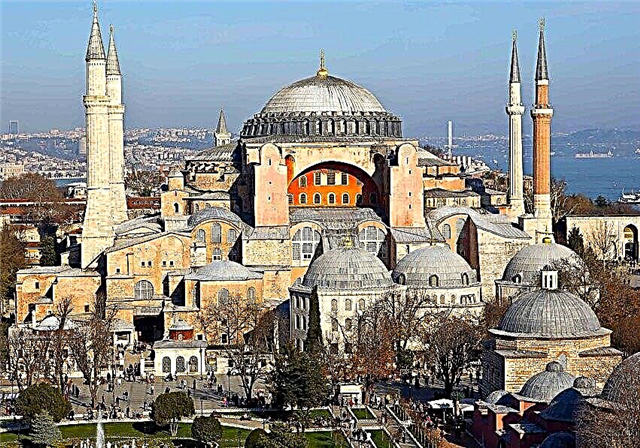Baikonur Cosmodrome - the first and also the largest cosmodrome on the planet. It is located in Kazakhstan near the Tyuratam village and covers an area of 6717 km².
It was from Baikonur in 1957 that the R-7 rocket was launched with the 1st artificial Earth satellite, and 4 years later the first man in history, Yuri Gagarin, was successfully sent into space from here. In subsequent years, the N-1 lunar rockets and the Zarya module were launched from this site, from which the construction of the International Space Station (ISS) began.

Creation of a cosmodrome
In 1954, a special commission was organized to select a suitable site for the construction of a military and space training ground. The following year, the Communist Party approved a decree on the creation of a test site for the flight testing of the 1st Soviet intercontinental ballistic missile "R-7" in the desert of Kazakhstan.
This area met a number of criteria required for the development of a large-scale project, including the sparse population of the region, drinking water sources and availability of rail links.
The famous designer of rocket and space systems Sergei Korolev also advocated the construction of a cosmodrome in this place. He motivated his decision by the fact that the closer the take-off site is to the equator, the easier it will be to use the rotation speed of our planet.
The Baikonur cosmodrome was founded on June 2, 1955. Month after month, the desert area turned into a huge technical complex with a developed infrastructure.
In parallel with this, a city for testers was being rebuilt in the immediate vicinity of the site. As a result, the landfill and the village received the nickname "Zarya".
Launch history
The first launch from Baikonur was made on May 15, 1957, but it ended in failure due to the explosion of one of the rocket blocks. After about 3 months, the scientists still managed to successfully launch the R-7 rocket, which delivered the conventional ammunition to the specified destination.
In the same year, on October 4, the PS-1 artificial earth satellite was successfully launched. This event marked the beginning of the space age. "PS-1" was in orbit for 3 months, having managed to circumnavigate our planet 1440 times! It is curious that his radio transmitters worked for 2 weeks after the start.
4 years later, another historic event took place that shocked the whole world. On April 12, 1961, the Vostok spacecraft was successfully launched from the cosmodrome, with Yuri Gagarin on board.
An interesting fact is that it was then that the top-secret military training ground was first named Baikonur, which literally means "rich valley" in Kazakh.

On June 16, 1963, the first woman in history, Valentina Tereshkova, visited space. After that, she was awarded the title of Hero of the Soviet Union. Subsequently, thousands more launches of various rockets were made at the Baikonur cosmodrome.
At the same time, programs for the launch of manned spacecraft, interplanetary stations, etc. continued. In May 1987, the Energia launch vehicle was successfully launched from Baikonur. A year and a half later, with the help of Energia, the first and last launch of the reusable spacecraft-rocket plane Buran was made.
After completing two revolutions around the Earth "Buran" landed safely at the cosmodrome. An interesting fact is that its landing took place in a fully automatic mode and without a crew.
In the period 1971-1991. 7 Salyut space stations were launched from the Baikonur cosmodrome. From 1986 to 2001, modules of the famous Mir complex and the ISS, which are still functioning today, were sent into space.
Rent and operation of the cosmodrome by Russia
After the collapse of the USSR in 1991, Baikonur came under the control of Kazakhstan. In 1994, the cosmodrome was leased to Russia, which amounted to $ 115 million per year.
In 1997, a gradual transfer of the cosmodrome facilities from the RF Ministry of Defense to the management of Roscosmos began, and later to civilian enterprises, the key of which are:
- Branch of FSUE TSENKI;
- RSC Energia;
- GKNTSP them. M. V. Khrunicheva;
- TsSKB-Progress.
Currently Baikonur has 9 launch complexes for launching carrier rockets, with many launchers and filling stations. According to the agreement, Baikonur was leased to Russia until 2050.

The cosmodrome infrastructure includes 2 aerodromes, 470 km of railway lines, over 1200 km of highways, over 6600 km of power transmission lines and about 2780 km of communication lines. The total number of employees in Baikonur is over 10,000.
Baikonur today
Now work is underway to create a space-rocket complex "Baiterek" jointly with Kazakhstan. Tests should start in 2023, but this may not happen due to the coronavirus pandemic.
During the operation of the cosmodrome, up to 5000 launches of various rockets were carried out from its test site. Throughout history, about 150 astronauts from various countries went into space from here. In the period 1992-2019. 530 launches of carrier rockets took place.
Until 2016, Baikonur held the world leadership in the number of launches. However, since 2016, the first place in this indicator has been taken by the American spaceport Cape Canaveral. It is curious that in total the Baikonur cosmodrome and the city cost the Russian state budget more than 10 billion rubles a year.
There is a movement of activists "Antiheptil" in Kazakhstan, which criticizes the activities of Baikonur. Its participants openly declare that the cosmodrome is the cause of environmental degradation in the region from the harmful waste of the heavy-class "Proton" launch vehicle. In this regard, protest actions are repeatedly organized here.
Photo of the Baikonur cosmodrome
















